

Liv-ex - The global marketplace for the wine trade. Price, source & sell wine. Why Content Knowledge is Crucial to Effective Critical Thinking. Willingham wrote a paper, “How to Teach Critical Thinking,” in May 2019 for the Department of Education of New South Wales in Australia.
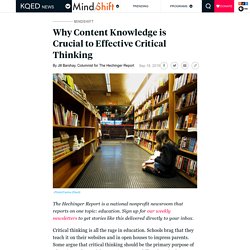
But it is entirely applicable to the American context. In the paper, Willingham traces the history of teaching critical thinking. More than a century ago, many thought that difficult subjects like Latin might improve thinking abilities. But scientists subsequently found that students who studied Latin didn’t do any better on tests than those who didn’t. There are mixed results from more recent studies in teaching students computer science. To be sure, there are basic logic principles that are true across subjects, such as understanding that “A” and “not A” cannot simultaneously be true.
To help student see analogies, “show students two solved problems with different surface structures but the same deep structure and ask them to compare them,” Williingham advises teachers, citing a pedagogical technique proven to work by researchers in 2013. Cultural Access. 1 in 5 Americans has a Disability.

VSA Ohio now offers professional development opportunities and trainings to increase access and inclusion in your organization and community. Disability Resources & Educational Services - University of Illinois. We often field questions from well-meaning students, faculty, staff and practitioners who are looking for a “disability experience” and ask to borrow a wheelchair or physical device or wear goggles or do some other type of disability simulation in order to experience what it is like “to have a disability.”
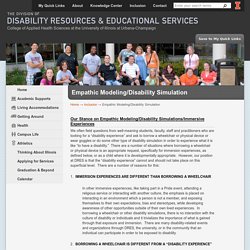
There are a number of situations where borrowing a wheelchair or physical device is an appropriate request, specifically for immersion experiences, as defined below, or as a child where it is developmentally appropriate. However, our position at DRES is that the “disability experience” cannot and should not take place on this superficial level. Evelyn Glennie: How to truly listen. Disability Simulations: What Does the Research Say? Disability Resources & Educational Services - University of Illinois. General Disabilities Video Short Taking Charge: Stories of Success and Self-determination University of Washington focuses on defining success, setting goals, understanding abilities/disabilities and how to play to strengths, etc.

Disability Resources & Educational Services - University of Illinois. Youth. Autistic Hoya: Definitions. These are definitions of terms that I use frequently in my writing, provided for your convenience and reference.
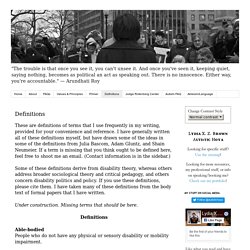
I have generally written all of these definitions myself, but have drawn some of the ideas in some of the definitions from Julia Bascom, Adam Gluntz, and Shain Neumeier. If a term is missing that you think ought to be defined here, feel free to shoot me an email. Autistic Hoya: Ableism/Language. Last updated 7 December 2016.

Page created in or before July 2012 (exact date unknown). Note that some of the words on this page are actually slurs but many of the words and phrases on this page are not considered slurs, and in fact, may not actually be hurtful, upsetting, retraumatizing, or offensive to many disabled people. They are simply considered ableist (the way that referring to a woman as emotionally fragile is sexist, but not a slur). You're not automatically a bad or evil person/activist if you have used random language on here, but if you have the cognitive/language privilege to adjust your language, it's definitely worthwhile to consider becoming more aware/conscious of how everyday language helps perpetuate ableist ideas and values.For my most recent perspective on linguistic ableism and the reason that this page exists, see this post: Violence in Language: Circling Back to Linguistic Ableism.
Contrast: Evaluation Procedures: University of Michigan Web Accessibility. Sufficient color contrast is necessary for visually impaired users to view your web content.
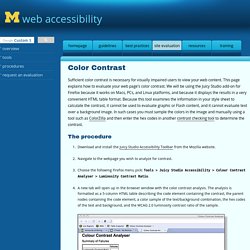
This page explains how to evaluate your web page’s color contrast. We will be using the Juicy Studio add-on for Firefox because it works on Macs, PCs, and Linux platforms, and because it displays the results in a very convenient HTML table format. Because this tool examines the information in your style sheet to calculate the contrast, it cannot be used to evaluate graphic or Flash content, and it cannot evaluate text over a background image. In such cases you must sample the colors in the image and manually using a tool such as ColorZilla and then enter the hex codes in another contrast checking tool to determine the contrast. Download and install the Juicy Studio Accessibility Toolbar from the Mozilla website. Color Contrast: Best Practices: University of Michigan Web Accessibility. Color contrast is an important but often overlooked aspect of web accessibility.

Many more people are visually impaired or color blind than are legally blind. So by ignoring the color contrast of your page, you will be affecting a significant portion of your audience. During the design phase, you will want to check your web templates’ color contrast and adjust it accordingly. Although you can sense when a page has poor contrast, there are tools that can quantify the contrast between text and its background based on the style sheet and return a result in the form of a ratio. Websites that satisfy WCAG 2.0 must have a contrast ratio of 4.5:1 or higher.
10 colour contrast checking tools to improve the accessibility of your design. Color & Contrast. Best Practices Breakdown: Color Contrast – Daktronics. This week marks the final chapter in our series about content creation best practices.

Today, we will discuss color contrast, why it’s important, and how to apply to make the best-possible-looking messages for your display. If you haven’t read the first two chapters in our series, click the links below! Contrast Defined So, what is contrast exactly? It is the state of being strikingly different (in color or brightness) from something else, typically something in juxtaposition or close proximity. Contrast between colors is key! 7 Website Color Scheme Best Practices.
Color has a powerful effect on people.
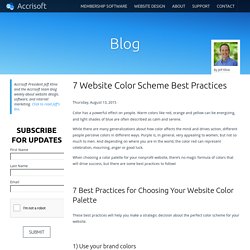
Warm colors like red, orange and yellow can be energizing, and light shades of blue are often described as calm and serene. While there are many generalizations about how color affects the mind and drives action, different people perceive colors in different ways. Purple is, in general, very appealing to women, but not so much to men. And depending on where you are in the world, the color red can represent celebration, mourning, anger or good luck. When choosing a color palette for your nonprofit website, there’s no magic formula of colors that will drive success, but there are some best practices to follow! National Center on Disability and Journalism. The style guide is intended for journalists, communication professionals and members of the general public who are seeking the appropriate and accurate language to use when writing or talking about people living with disabilities. The guide covers general terms and words on physical disabilities, hearing and visual impairments, mental and cognitive disabilities and seizure disorders.
Entries are listed in alphabetical order. Click on the index to the left to jump to entries that begin with that letter. Each entry includes a definition of the word or term, a summary of how it is used or viewed by disability groups and guidance, when available, from The Associated Press Stylebook. 4 Ways Microsoft is Making Learning More Accessible. Design for Accessibility. Design for Accessibility: A Cultural Administrator's Handbook. Accessibility 201: Relax and Create Sensory Friendly Experiences. Cultural Access. 1 in 5 Americans has a Disability. Here are 5 reasons to care about accessibilty and inclusion: 1. It's the law. 2.
It makes good business sense. 3. 4. 5. Department of Justice ADA Guide for Small Towns. Americans with Disabilities Act ADA Guide for Small Towns A guide for small local governments including towns, townships, and rural counties. Reproduction Reproduction of this document is encouraged. Additional copies of this publication may be obtained by calling the ADA Information Line at 800-514-0301 (voice) 800-514-0383 (tty) or by visiting the Department's ADA Home Page on the World Wide Web ( Disclaimer The ADA authorizes the Department of Justice to provide technical assistance to individuals and entities that have rights or responsibilities under the Act.
First printing, March 2000. ReelAccess Film Festivals E Guide Toronto. A Planning Guide for Making Temporary Events Accessible to People With Disabilities. Accessible Meetings Toolkit.authcheckdam. Color & Contrast. Untitled. Untitled. Untitled. National Center on Disability and Journalism. Design-for-Accessibility. Design for Accessibility: A Cultural Administrator's Handbook. The Teacher Curse No One Wants to Talk About. Knowledge is a curse. Knowing things isn’t bad in itself, but it causes unhealthy assumptions—such as forgetting how hard it was to learn those things in the first place. It’s called the Curse of Knowledge. In this post, we’ll identify how the Curse of Knowledge affects educators. Then we’ll outline seven ways to alleviate the curse. The ultimate goal is to improve instruction. Why Identity and Emotion are Central To Motivating the Teen Brain.
ED498555. ED498555. Asle2014. Millennials confident connected open to change. UDL On Campus: Home. Things I’m Sick of Hearing as a Person With a Disability. As parents of kids with disabilities, we want our children to be treated with dignity and respect. But what if we as parents don’t model that? I’m going to say something that I suspect will make a lot of people uncomfortable: sometimes we are the ones who treat our children in undignified ways. When I first realized I was guilty of this, it broke me. FinalprofessionalpapersbookArticle3. Three Books I’m Buying after Attending the #UDL4Justice Conference. The Case for Quiet Kids: Helping Introverts Get Heard in the Classroom. 6 Strategies for Differentiated Instruction in Project-Based Learning. Supporting Students' College Success: The Role of Assessment of Intrapersonal and Interpersonal Competencies.
Below is the uncorrected machine-read text of this chapter, intended to provide our own search engines and external engines with highly rich, chapter-representative searchable text of each book. Because it is UNCORRECTED material, please consider the following text as a useful but insufficient proxy for the authoritative book pages. New National Academies Of Science Report Identifies Three Qualities Key To Student Success. Using Playlists to Differentiate Instruction. 6 Powerful Learning Strategies You MUST Share with Students. The Autism-Genius Connection. Cast 5 learning environs. Cast 5 stereotype threat r. Instructional Process. Free UDL Resources and Tips.
Lesson Plan: Neurodiversity: Negotiating the World… Differently. Download the Lesson Plan. MyWays Learning. Katie Novak on UDL Now! Revised. 10. Has educational neuroscience actually had an impact on education so far? The last reason is that there are certain basic cognitive skills that need to be developed. Stella Young: I'm not your inspiration, thank you very much. UDL Versus Traditional Classrooms Tutorial. Download PDF. Microsoft's Radical Bet On A New Type Of Design Thinking. ZhaoIndicators.
10 Strategies and Practices That Can Help All Students Overcome Barriers. Creating a Welcoming Classroom for Students with Special Needs. Universal Design for Learning: Creating a Learning Environment that Challenges and Engages All Students. Special Populations and the Arts. Eligibility for Special Education Services: Articles, Resouces and Decisions from Wrightslaw. Determining Special Education Eligibility. Understanding the 13 Categories of Special Education. The Individualized Education Program Process in Special Education. 4 Things You Don't Know About the Jigsaw Method. Carol Dweck Revisits the 'Growth Mindset'
What is Mindset. Creating accessible materials. Zabala SETT Leveling the Learning Field. SETT Documents. Creating accessible PowerPoint presentations. How to Make Your PowerPt Presentations Accessible5 199082 7. Center for Instructional Supports and Accessible Materials. Ohio Coalition for the Education of Children with Disabilities. ORC - 3329.01 Adoption and purchase of textbooks or electronic textbooks - filing of price statement. AEM: AEM State Contacts and SEA Information. AEM: Creating AEM. AEM: Best Practices for Educators & Instructors. 2020's Learning Landscape: A Retrospective on Dyslexia.
2020LearningLandscape. AEM: Home. Try The McGurk Effect! - Horizon: Is Seeing Believing? - BBC Two. UDL-CCSS Video Crosswalk. Literacy Design Collaborative. UDL-LDC Crosswalk. UDL Exchange: Home. TAKE A TOUR: LEARN ABOUT UNIVERSAL DESIGN FOR LEARNING. SXSWedu 2017 #UDLmakers update. Cast 5 stereotype threat. Home. Untitled. Untitled.